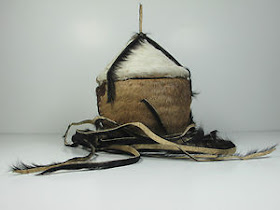Injera is a spongy flat bread that is a central part of Ethiopian cuisine. It's actually used in Eritrean, Somalian and Yemeni dishes as well but it is Ethiopian food that has emerged as a trendy cuisine in the west and it is definitely Ethiopian dishes that pop culture associates injera with . If you didn't already know, injera - and especially injera made from teff - is a really healthy bread to eat !
Teff
Teff has the highest content of calcium in the world of grains. Actually it leads the grain world for calcium content by a wide margin. A cup of cooked teff offers 123 mg of calcium which is about the same amount as you would get in a half cup of cooked spinach!
Teff is also high in 'resistant starch' which is a type of dietary fiber that can benefit blood-sugar management, weight control, and colon health. It’s estimated that 20-40% of the carbohydrates in teff are resistant starches.
| Teff [Eragrostis tef] is the only fully-domesticated member of the genus Eragrostis (lovegrass). |
|---|
Believe it or not teff is also a excellent source of vitamin C, a nutrient not commonly found in grains . Teff WAS long believed to be high in iron, but more recent tests have shown that its iron content comes from soil mixed with the grain after it’s been threshed on the ground – the grain itself is not unusually high in iron. So the iron content will depend on where you buy your teff or injera from. Tef grains are reported to contain 9-11 percent protein, an amount slightly higher than in normal sorghum, maize, or oats. Samples tested in the United States have consistently shown even higher protein levels: 14-15 percent.
Teff is actually an annual grass, a species of lovegrass, that is native to the northern Ethiopian Highlands. Since teff’s bran and germ make up a large percentage of the tiny grain, and it’s too small to process, teff is always eaten in its whole form. It’s been estimated that Ethiopians get about two-thirds of their dietary protein from teff. Many of Ethiopia’s famed long-distance runners attribute their energy and health to teff .
.jpg) |
| Harvesting teff in Ethiopia |
Today, teff is moving way beyond its traditional use . As mentioned above it is a healthy, gluten-free grain, it also has a mild flavour and has proven to be a versatile ingredient for many products. It can now be found in pancakes, snacks, breads, cereals and many other products.
|
|---|
A Wee Bit of History:
 |
| Ploughing in Tigray. Etching from 1868. |
Making INJERA
When making injera the tef flour is mixed with water and allowed to ferment for a few days . This fermentation is a bit of a delicate process and is temperature and humidity sensitive. Traditionally the batter prepared is cooked either on a wide specialized circular electric stove or a wide circular pan made of clay using fire.
| Traditional Injera Recipe:
1 1/2 cups ground teff (180 g)
2 cups water
|
|---|
Injera is spread out on a large plate, placed between the guests for all to share the food from the same plate and chosen dishes (like doro wat or alicha) are ladled on top. Additional injera is served on the side and guests
use the
injera to scoop up their food.
A more ancient tradition is for guests to gather at low-sitting table like the one pictured in the traditional icon painting style, below.
Did you know? There are traditional 'lunch boxes' called agelgil which were specially designed to carry injera and the ethiopian cultural cuisine.
 |
| A type of Agelgil |
Links for further reading:
As Americans embrace Ethiopian cuisine, its farmers grow more teff: http://articles.washingtonpost.com/2012-07-29/lifestyle/35487820_1_dukem-tibs-ethiopians via Washington Post.
Health benefits, cooking tips and recipes, historical/cultural facts and more: http://wholegrainscouncil.org/whole-grains-101/teff-and-millet-november-grains-of-the-month via Whole Grains Council.
The nutritional promise of teff and some explanations: http://books.nap.edu/openbook.php?record_id=2305&page=222 via National Academies Press.
All about teff: http://en.wikipedia.org/wiki/Eragrostis_tef via Wikipedia.


.JPG)

No comments:
Post a Comment